How This Underwear Brand Won with an Anti-Black-Friday Social Campaign

In less than a year, Hootsuite worked our way up from zero to more than 11,000 TikTok followers. This is what we learned along the way.


In less than a year, Hootsuite worked our way up from zero to more than 11,000 TikTok followers. This is what we learned along the way.




Google officially launched 24 years ago in 1998.
A lot has changed since then, but one thing remains the same. If you simply focus on the basics, you can still be highly successful online.
Of course, the basics in 2022 are much different from the basics in 1998. It’s easy to get overwhelmed and distracted. It has never been more important to be disciplined in one’s approach to SEO.
So, the obvious question is this: What are the factors to concentrate on? How can one boost rankings? How can anyone build traffic in such a competitive environment?
This post will delve into which factors carry the most weight and how to optimize for each.
As machine learning, artificial intelligence, and deep learning continue to evolve, each will carry more weight in the Google Core Algorithm.
The end goal for Google is to understand the context of a given search query and to serve results consistent with the user intent. This makes advanced-level keyword research and keyword selection more important than ever.
Before spending time and resources trying to rank for a phrase, you will need to look at the websites that are currently at the top of the SERPs for that phrase.
A keyword’s contextual relevance must align with a search query. There will be some keywords and queries that will be impossible to rank for.
For example, if Google has determined that people searching for “Personal Injury Attorney [insert city]” want a list of lawyers to choose from, then a series of trusted law directories will appear at the top of the SERPs.
An individual or single firm will not supplant those directories. In those cases, you will need to refine your strategy.
The foundation for technical SEO is having a solid website architecture.
One cannot simply publish a random collection of pages and posts. An SEO-friendly site architecture will guide users throughout your site and make it easy for Google to crawl and index your pages.
Once you have the right architecture in place, it’s time to perform a technical or SEO audit.
Thanks to the many SEO tools available, an SEO audit is no longer a daunting task. That said, the key is to know how to interpret the data provided and what to do with it.
For starters, you should check the following and fix any issues that are uncovered:
User experience (UX) is centered on gaining insight into users, their needs, their values, their abilities, and their limitations.
UX also takes into consideration business goals and objectives. The best UX practices focus on improving the quality of the user experience.
According to Peter Morville, factors that influence UX include:
Multivariate and A/B testing is the best way to measure and create a better experience for website users. Multivariate testing is best when considering complex changes.
One can incorporate many different elements and test how they all work together. A/B testing, on the other hand, will compare two different elements on your site to determine which performs the best.
Google officially began rolling out the mobile-first index in March 2018. Smart marketers were taking a mobile-first approach long before the official rollout.
According to Google Search Central:
“Neither mobile-friendliness nor a mobile-responsive layout are requirements for mobile-first indexing. Pages without mobile versions still work on mobile and are usable for indexing. That said, it’s about time to move from desktop-only and embrace mobile :)”
Here are some basics for making your site mobile-friendly:
In July of 2021, the Page Experience Update rolled out and is now incorporated into Google’s core algorithm, as a ranking factor.
As the name implies, the core web vitals initiative was designed to quantify the essential metrics for a healthy website. This syncs up with Google’s commitment to delivering the best user experience.
According to Google, “loading experience, interactivity, and visual stability of page content, and combined are the foundation of Core Web Vitals.”
Each one of these metrics:
Schema markup, once added to a webpage, creates a rich snippet – an enhanced description that appears in the search results.
All leading search engines, including Google, Yahoo, Bing, and Yandex, support the use of microdata. The real value of schema is that it can provide context to a webpage and improve the search experience.
There is no evidence that adding schema has any influence on SERPs.
Following, you will find some of the most popular uses for schema
If you find the thought of adding schema to a page intimidating, you shouldn’t. Schema is quite simple to implement. If you have a WordPress site, there are several plugins that will do this for you.
It is projected that 97 zettabytes of data will be created, captured, copied, and consumed worldwide this year.
To put this in perspective, that’s the equivalent of 18.7 trillion songs or 3,168 years of HD video every day.
The challenge of breaking through the clutter will become exponentially more difficult as time passes.
To do so:
Links continue to be one of the most important ranking factors.
Over the years, Google has become more adept at identifying and devaluing spammy links, especially so after the launch of Penguin 4.0. That being the case, quality will continue to trump quantity.
The best link-building strategies for 2022 include:
You manage what you measure.
One recent study showed that less than 50% of pages “optimized” result in more clicks. Worse yet, 34% of changes led to a decrease in clicks!
Basic steps for SEO testing:
This process can be easily executed and documented by using a spreadsheet.
According to Roger Monti, the following are the 9 Most Important SEO KPIs to consider:
The thing to remember about these KPIs is they are dependent upon your goals and objectives. Some may apply to your situation whereas others may not.
Think of this as a good starting point for determining how to best measure the success of a campaign.
Because the internet has no expiration date, mounds of information and disinformation are served up daily in various search queries.
If you aren’t careful, implementing bad or outdated advice can lead to disastrous results.
Do yourself a favor and just focus on these 10 essentials. By doing so, you will be setting yourself up for long-term success.
More Resources:
Featured Image: Rawpixel.com/Shutterstock

We all know that customers interact with a brand through multiple channels and campaigns (online and offline) along their path to conversion.
Surprisingly, within the B2B sector, the average customer is exposed to a brand 36 times before converting into a customer.
With so many touchpoints, it is difficult to really pin down just how much a marketing channel or campaign influenced the decision to buy.
This is where marketing attribution comes in.
Marketing attribution provides insights into the most effective touchpoints along the buyer journey.
In this comprehensive guide, we simplify everything you need to know to get started with marketing attribution models, including an overview of your options and how to use them.
Marketing attribution is the rule (or set of rules) that says how the credit for a conversion is distributed across a buyer’s journey.
How much credit each touchpoint should get is one of the more complicated marketing topics, which is why so many different types of attribution models are used today.
There are six common attribution models, and each distributes conversion value across the buyer’s journey differently.
Don’t worry. We will help you understand all of the models below so you can decide which is best for your needs.
Note: The examples in this guide use Google Analytics 4 cross-channel rules-based models.
Cross-channel rules-based means that it ignores direct traffic. This may not be the case if you use alternative analytics software.
The last click attribution model gives all the credit to the marketing touchpoint that happens directly before conversion.
Last Click helps you understand which marketing efforts close sales.
For example, a user initially discovers your brand by watching a YouTube Ad for 30 seconds (engaged view).
Later that day, the same user Googles your brand and clicks through an organic search result.
The following week this user is shown a retargeting ad on Facebook, clicks through, and signs up for your email newsletter.
The next day, they click through the email and convert to a customer.
Under a last-click attribution model, 100% of the credit for that conversion is given to email, the touchpoint that closed the sale.
The first click is the opposite of the last click attribution model.
All of the credit for any conversion that may happen is awarded to the first interaction.
The first click helps you to understand which channels create brand awareness.
It doesn’t matter if the customer clicked through a retargeting ad and later converted through an email visit.
If the customer initially interacted with your brand through an engaged YouTube view, Paid Video gets full credit for that conversion because it started the journey.
Linear attribution provides a look at your marketing strategy as a whole.
This model is especially useful if you need to maintain awareness throughout the entire buyer journey.
Credit for conversion is split evenly among all the channels a customer interacts with.
Let’s look at our example: Each of the four touchpoints (Paid Video, Organic, Paid Social, and Email) all get 25% of the conversion value because they’re all given equal credit.
Time Decay is useful for short sales cycles like a promotion because it considers when each touchpoint occurred.
The first touch gets the least amount of credit, while the last click gets the most.
Using our example:
Note: Google Analytics 4 distributes this credit using a seven-day half-life.
The position-based (U-shaped) approach divides credit for a sale between the two most critical interactions: how a client discovered your brand and the interaction that generated a conversion.
With position-based attribution modeling, Paid Video (YouTube engaged view) and Email would each get 40% of the credit because they were the first and last interaction within our example.
Organic search and the Facebook Ad would each get 10%.
Google Analytics 4 has a unique data-driven attribution model that uses machine learning algorithms.
Credit is assigned based on how each touchpoint changes the estimated conversion probability.
It uses each advertiser’s data to calculate the actual contribution an interaction had for every conversion event.
There isn’t necessarily a “best” marketing attribution model, and there’s no reason to limit yourself to just one.
Comparing performance under different attribution models will help you to understand the importance of multiple touchpoints along your buyer journey.
If you want to see how performance changes by attribution model, you can do that easily with GA4.
To access model comparison in Google Analytics 4, click “Advertising” in the left-hand menu and then click “Model comparison” under “Attribution.”






By default, the conversion events will be all, the date range will be the last 28 days, and the dimension will be the default channel grouping.
Start by selecting the date range and conversion event you want to analyze.
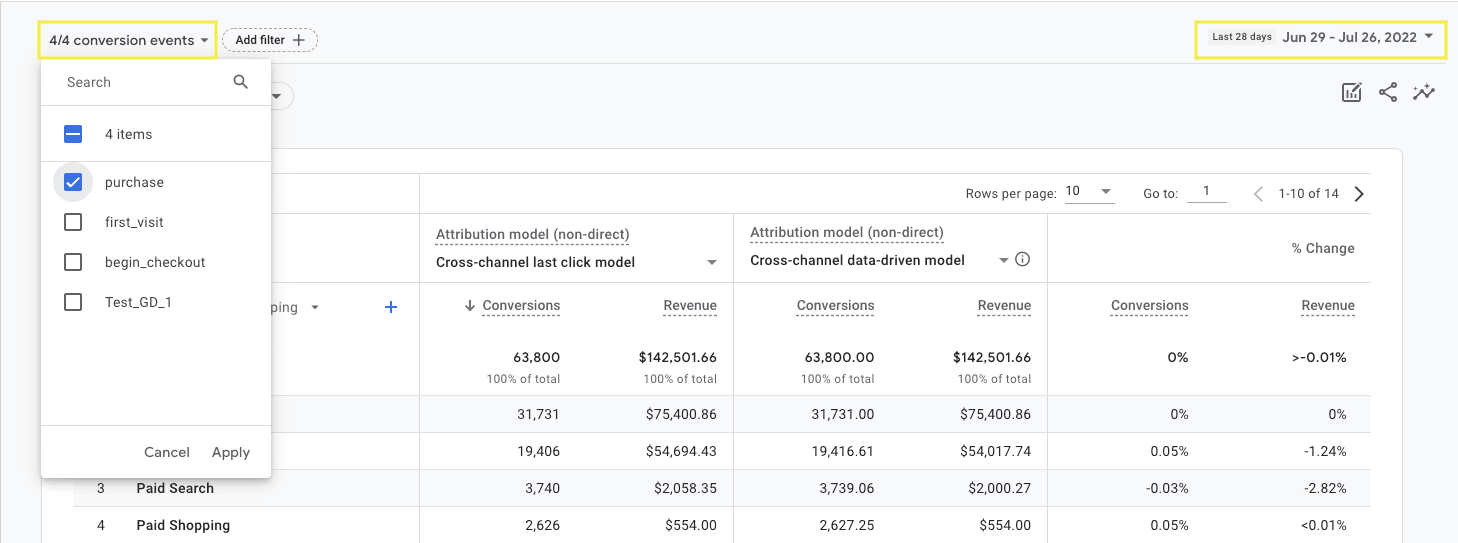





You can add a filter to view a specific campaign, geographic location, or device using the edit comparison option in the top right of the report.






Select the dimension to report on and then use the drown-down menus to select the attribution models to compare.
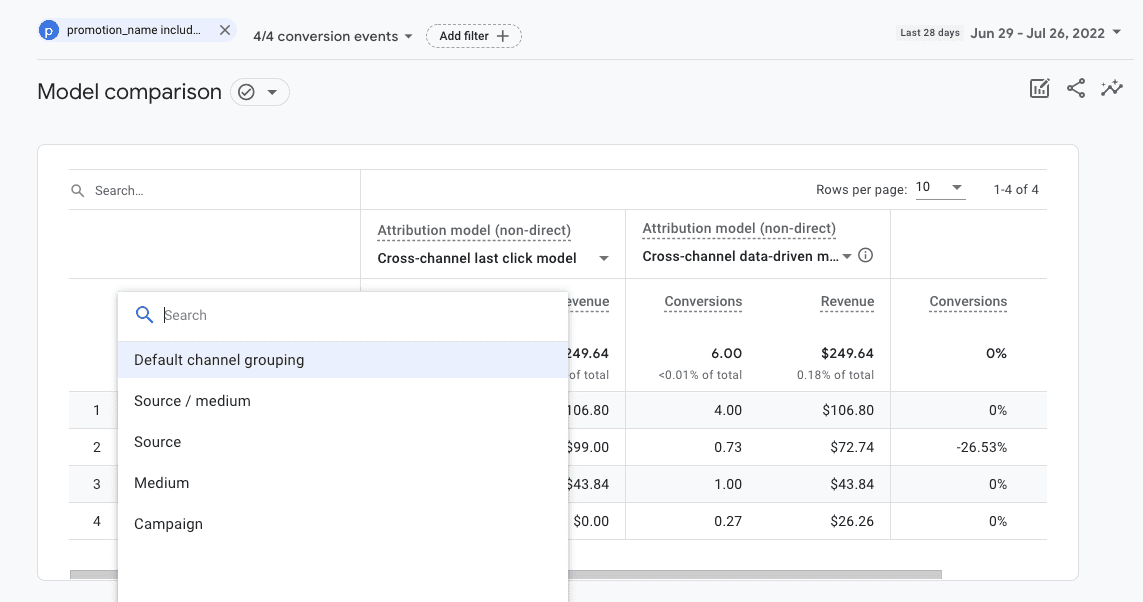





Let’s say you’re asked to increase new customers to the website.
You could open Google Analytics 4 and compare the “last-click” model to the “first-click” model to discover which marketing efforts start customers down the path to conversion.
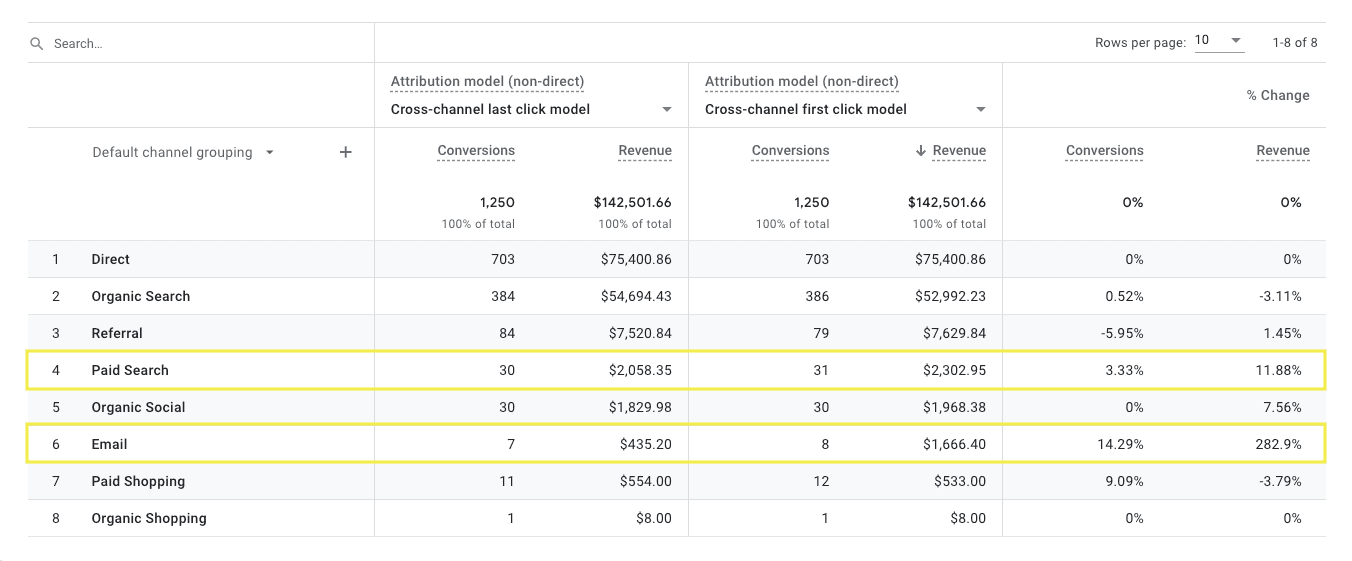





In the example above, we may choose to look further into the email and paid search further because they appear to be more effective at starting customers down the path to conversion than closing the sale.
If you choose a different attribution model for your company, you can edit your attribution settings by clicking the gear icon in the bottom left-hand corner.
Open Attribution Settings under the property column and click the Reporting attribution model drop-down menu.
Here you can choose from the six cross-channel attribution models discussed above or the “ads-preferred last click model.”
Ads-preferred gives full credit to the last Google Ads click along the conversion path.






Please note that attribution model changes will apply to historical and future data.
Determining where and when a lead or purchase occurred is easy. The hard part is defining the reason behind a lead or purchase.
Comparing attribution modeling reports help us to understand how the entire buyer journey supported the conversion.
Looking at this information in greater depth enables marketers to maximize ROI.
Got questions? Let us know on Twitter or Linkedin.
More Resources:
Featured Image: Andrii Yalanskyi/Shutterstock

Today’s consumers don’t just enjoy content personalization – they expect it.
Yet, far too often, we think adding
In this article, we’ll look at why personalization matters, and how to get started implementing personalization across your customer journey.
Personalization is all about cutting down the noise and delivering exactly what your customer or client needs to hear.
It’s a way to make a deeper and more meaningful connection with the people you’re trying to reach.
From a business perspective, personalization has a huge return on investment (ROI).
Epsilon research found that when companies use personalization in their content, 80% of customers are more likely to make a purchase.
And according to Google research, a highly personalized shopping experience makes customers 40% more likely to spend more than they had originally planned.
If you want to create high-performing content that delights and engages your customers, personalization is key.
The backbone of any personalization strategy is data.
Metadata is simply information about your data. Why is this important?
Well, to personalize content, you need to connect your customers to the correct content, which means you need data about both customers and content.
Once you collect customer data, you can use this information to create custom content.
The more information you have about our content, the easier it will be to direct it to the right audience.
One way to do this is by tagging your content with information like audience, persona, funnel stage, and campaign.
You can tag content in many CMS (content management systems) like HubSpot.
Email is a terrific area to begin incorporating some content personalization.
Adding first names to email subjects is a common place to start, but there’s so much more you can do.
Let’s look at some examples.
If a tech company sends out a marketing email to its entire email list promoting a sale, that’s pretty good.
But what would be better is sending out a promotional email to different groups based on their persona. This way you can personalize the content based on interest.
Instead of sending a generic “thank you” email after someone downloads a resource, send them an email suggesting more content related to what they downloaded.
We sent this email to prospective customers who may be interested in this white paper based on their persona.






With some basic analytics, you can discover which website pages your potential clients are spending the most time on.
And if they submit an email address for a newsletter or download, you can follow along their exact journey on your website.
Using this data you can create personalized emails that specifically target the information they’re interacting with.
Now, this strategy isn’t scalable, and it would take way too much time to track every single prospect.
But for B2B businesses, it’s worth it to analyze your prospect journeys and make note of any potentially large and in-target customers.
A few well-placed emails to an already interested prospect can make a world of difference.
If your business is international, you can create marketing emails that reflect the local seasons and holidays of your customers.
More important than trying to recognize each holiday on the planet is simply to recognize that your customers don’t all live in the same area.
I would suggest that not sending a “Welcome Summer” email to your Australian customers at the beginning of June is actually a form of personalization.
Instead, make sure any references to holidays, sports, and weather are relevant to the location where you’re sending the email.
This is a great way to show that you understand the global nature of your business.
Instead of offering all of your products or services to customers, help them discover content focused on what they’re already interested in.
This could be as simple as asking which topics they’d like to learn more about on an email sign-up form.
You can also use data about what your customers have already purchased, pages they’ve viewed, and videos they’ve watched to set up an interest-based workflow.
Here’s an example of a marketing email we sent out after a conference. Based on which link the recipient clicked, they were put into a workflow customized to their interests.
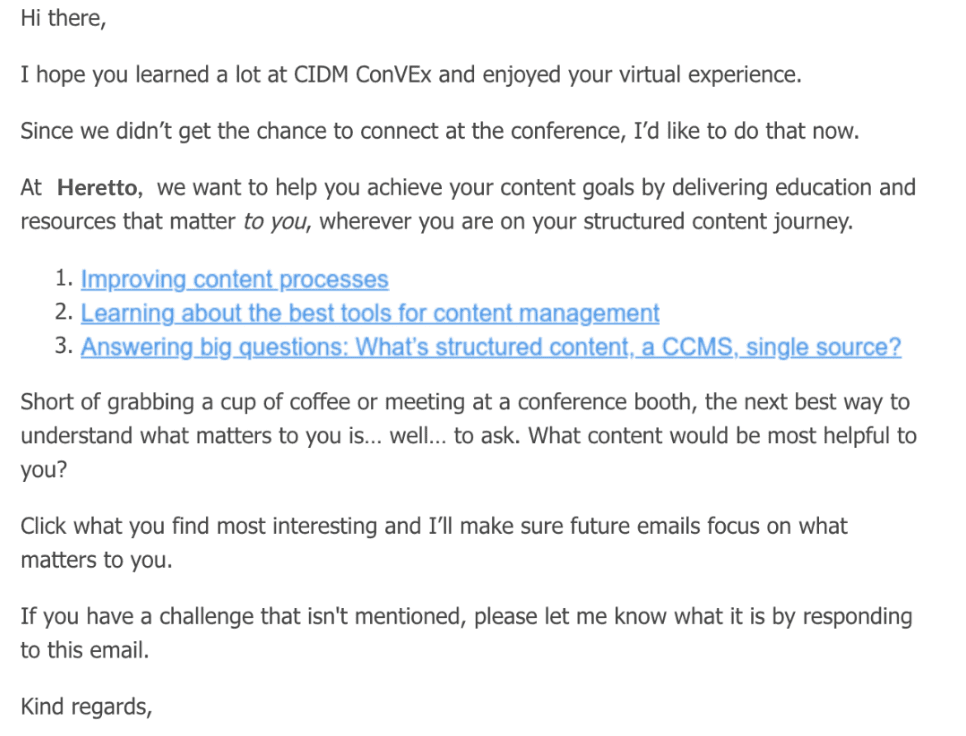





Personalizing content based on persona is especially important for B2B organizations.
The messaging we use to communicate with C-suite professionals is different than how we present our message to technical writers.
Your different target audiences will have different challenges and pain points.
Hopefully, you’re already keeping this in mind when creating your content and tagging it accordingly.
Once you do this, you can easily pull together content for each persona and create an email sequence that speaks directly to them.
Do you know where your potential customers are on the buyer’s journey?
Someone who’s just hearing about your product for the first time is going to want different information than someone who’s deep in the middle of researching potential options.
You need to make sure that you’re creating a variety of content that reaches the top of the funnel prospects all the way to the bottom of the funnel.
Once you have this content created, you can share it with the appropriate audience. One way to do this is by suggesting more articles to read that are for a similar place in the funnel.
Calls to action (CTAs) offer your potential customers a clear way to respond to your content and help move them down the funnel.
You should be testing out different CTAs and noting which ones work best.
You can use customized CTAs to deliver a highly-personalized action step.
This first example is a basic CTA. It’s good, but it’s very general.






This CTA is personalized. We know that Jim is interested specifically in laptops, so we personalize the message for him.






Creating customized content can seem overwhelming at first, so it’s best to pick one area and test it until you learn what works well for your organization.
And there are plenty of tools out there to help you enable personalization in your content, such as Keystone, Recombee, and Algolia.
The editorial staff also recommends Piano Analytics + Activation.
Begin by solidifying buyer personas and creating contact lists based on them. From there, you could easily create a segmented email campaign.
Soon you’ll be on your way to cultivating better customer experiences.
And once you begin to see the power of personalization in your content, you’ll never go back.
More resources:
Featured Image: Mix and Match Studio/Shutterstock

China Report is MIT Technology Review’s newsletter about technology developments in China. Sign up to receive it in your inbox every Tuesday.
This morning, I published an explainer on China’s social credit system. The government released a draft law on November 14 that will eventually serve as the top-level guidance on how the country builds the system.
That’s right, the national Chinese social credit system is not even fully built yet—but you’d be forgiven for thinking otherwise. Right now, it only really exists in fractured pieces. Still, there are a lot of Western misperceptions about it—particularly that there is an all-knowing algorithm that scores individual people’s daily behaviors. This doesn’t exist in reality, and in my story I explain what the system actually is and how we should understand social credits.
The real social credit system focuses on promoting trustworthiness in business, consumption, education, and … almost every other aspect of life. That sounds pretty good in theory, but in today’s newsletter, I want to dig into how this is all more complicated than it seems.
One particular example of the social credit system’s implications—specifically, how it can affect social media and freedom of speech—reveals how the noble-sounding goal of building trust can be problematic in practice.
The key question here is: Who is judging whether a social media comment or user is trustworthy? This is an incredibly difficult question that platforms around the world, including Twitter and Facebook, are still struggling to answer.
In China, though, the government seems confident that it can be the ultimate arbiter. So, as Princeton University researcher Shazeda Ahmed tells me, it’s necessary to ask: What does being trustworthy or honest mean in the eyes of the Chinese government?
In 2019, a draft regulation was introduced by China’s Cyberspace Administration to build a social credit system in the internet sector. It rules that government agencies can deem an individual or a company “seriously untrustworthy entities” for “fabricating, publishing, or transmitting information contrary to social mores, commercial morality, or honesty and credit.”
While some information can be fact-checked and proved false, things like “social mores” and “honesty” are often too vague to be defined objectively, so it goes back to the government to identify what makes a moral value.
Well, we have already seen how this can go terribly wrong. In the early months of covid-19, the local government in Wuhan punished eight individuals for posting “rumors” about the virus that allegedly undermined public trust. Li Wenliang, the whistleblower doctor who told friends in a group chat that a SARS-like virus was spreading, was summoned by the police for “posting lies online.” Later, his death from covid ignited a national wave of fury against the government’s control of information.
This is just one incident, but as the idea of building social creditworthiness increasingly seeps into other regulations, it reveals the risks of standardizing a practice wherein the government makes moral judgments for its people.
Just last week, China’s Cyberspace Administration finalized a regulation entirely dedicated to “online comments,” which I covered when it was first proposed in June. The regulation’s main purpose is to place social media interactions, including those in newer forms like livestreams, under the same strict controls China has always had for other online content.
These rules aren’t really part of the broader social credit system, but I still found some familiar language in the document. It asks social media platforms to “carry out credit assessments of users’ conduct in commenting on posts” and “conduct credit appraisals of public account producer-operators’ management of post comments.”
The idea is that if an influencer or a user posts things that are not trustworthy, that should be reflected in the person’s credit assessment. And the results of the credit assessment will determine “the scope of services and functionality” people are offered on certain platforms.
It’s not the only specific example of the Chinese government using importance of “creditworthiness” or “trust” to justify more rules. This was seen when the government decided to establish a blacklist of celebrities who promote “bad” morals, crack down on social media bots and spam, and designate responsibilities to administrators of private group chats.
This is all to say that the ongoing development of China’s social credit system is often in sync with the development of more authoritarian policies. “As China turns its focus increasingly to people’s social and cultural lives, further regulating the content of entertainment, education, and speech, those rules will also become subject to credit enforcement,” legal scholar Jeremy Daum wrote in 2021.
Nevertheless, before you go, I do want to caution against the tendency to exaggerate perceived risks, which has happened repeatedly when people have discussed the social credit system.
The good news is that so far, the intersection of social credit and the control of online speech has been very limited. The 2019 draft regulation to build a social credit system for the internet sector has still not become law. And a lot of the talk about establishing credit appraisal systems for social media, like the one requested by the latest regulation on online comments, looks more like wishful thinking than practical guidance at this point. Some social platforms do operate their own “credit scores”—Weibo has one for every user, and Douyin has one for shopping influencers—but these are more side features that few in China would say are top of mind.
Today, instead of worrying about the theoretical risk of how a social credit system could be used to stifle freedom of speech, it’s more important to put our time and resources into identifying what censorship mechanisms are already in place and running, like those social platforms routinely use to screen posts and ban accounts for discussing politically sensitive events (including the massive ban ahead of the 20th Party Congress). These are larger and more urgent threats to Chinese internet users than a social credit system that even the government hasn’t figured out yet.
What other concerns do you have about China’s social credit system? I’d love to know. Write me at zeyi@technologyreview.com
1. Taiwan’s parliament passed its own version of the US CHIPS Act, which aims to retain Taiwan’s lead in semiconductor manufacturing technology by giving out large corporate tax breaks. (Reuters $)
2. As Meta, Twitter, and Amazon conduct massive layoffs, TikTok is approaching some of their laid-off software engineers and is planning to double the staff at its office in Mountain View, California. (The Information $)
3. TikTok’s content moderation subcontractor in Colombia is being investigated by the country’s Ministry of Labor for traumatic working conditions and low pay. (Time)
4. Many senior FTX employees have left their free accommodations in the Bahamas and returned to Hong Kong, where the crypto exchange had a headquarters until 2021. (Semafor)
5. Wall Street investors are getting excited about Chinese stocks again, driven by recent covid policy changes in China and the Biden-Xi meeting. (Bloomberg $)
6. Chinese doctors say the country’s medical system is not prepared for the inevitable surge in covid cases when Beijing decides to further relax its zero-covid policies. (Financial Times $)
7. China’s 20- and 30-year-olds no longer want to work in manufacturing factories like their parents. And automation technologies can’t (yet) fill this labor gap. (Reuters $)
Almost a year after China’s top livestream influencer Viya was suddenly censored for tax evasion, she has reinvented herself as the head of a sprawling supply chain business and investment empire, Chinese publication Renwu reported.
Once known for being able to sell over a billion dollars’ worth of merchandise in one livestream, Viya (whose real name is Huang Wei) hit rock bottom in December 2021, when she was fined nearly $200 million by the Chinese government. All Chinese social media platforms subsequently banned her accounts. But Viya had already started turning her online influence toward building an e-commerce supply chain ecosystem long before her fall. While she never appeared in front of the public again, her business empire has survived. Two manufacturing startups that she invested in went public recently, and she may have made more cash than when she was still appearing in front of the cameras.
Um, that’s awkward. Ahead of a rugby competition between Hong Kong and South Korea held in a city near Seoul on November 13, the organizer mistakenly played “Glory to Hong Kong,” an unofficial anthem from the 2019 pro-democracy protests, instead of the Chinese national anthem. And it soon emerged that in at least two separate rugby competitions this year, the correct anthem was played, but the TV graphics still referred to it as “Glory to Hong Kong.” Instead of taking it like a champ, the Hong Kong government has launched a police investigation into the latest incident, and a particularly pro-Beijing legislator, Junius Ho, even called for the Hong Kong rugby team to be disbanded for not reacting while the wrong song was played.



Meta has created an AI that can beat humans at an online version of Diplomacy, a popular strategy game in which seven players compete for control of Europe by moving pieces around on a map. Unlike other board games that AI has mastered, such as chess and Go, Diplomacy requires players to talk to each other—forming alliances, negotiating tactics—and spot when others are bluffing.
The AI, called Cicero, ranked in the top 10% across 40 online games against 82 human players (who were not aware they were competing against a bot). In one eight-game tournament involving 21 players, Cicero came first. Meta described its work in a paper published in Science.
Learning to play Diplomacy is a big deal for several reasons. Not only does it involve multiple players, who make moves at the same time, but each turn is preceded by a brief negotiation in which players chat in pairs in an attempt to form alliances or gang up on rivals. After this round of negotiation, players then decide what pieces to move—and whether to honor or renege on a deal.
At each point in the game, Cicero models how the other players are likely to act based on the state of the board and its previous conversations with them. It then figures out how players can work together for mutual benefit and generates messages designed to achieve those aims.
To build Cicero, Meta marries two different types of AI: a reinforcement learning model that figures out what moves to make, and a large language model that negotiates with other players.
Cicero isn’t perfect. It still sent messages that contained errors, sometimes contradicting its own plans or making strategic blunders. But Meta claims that humans often chose to collaborate with it over other players.
And it’s significant because while games like chess or Go end with a winner and a loser, real-world problems typically do not have such straightforward resolutions. Finding trade-offs and workarounds is often more valuable than winning. Meta claims that Cicero is a step toward AI that can help with a range of complex problems requiring compromise, from planning routes around busy traffic to negotiating contracts.
This is today’s edition of The Download, our weekday newsletter that provides a daily dose of what’s going on in the world of technology.
Meta’s game-playing AI can make and break alliances like a human
Meta has created an AI that can beat humans at an online version of Diplomacy, a popular strategy game in which seven players compete for control of Europe by moving pieces around on a map. Unlike other board games that AI has mastered, such as chess and Go, Diplomacy requires players to talk to each other—forming alliances, negotiating tactics—and spot when others are bluffing.
Although Cicero made errors, it’s still a step towards AI that can help with complex problems that require compromise, from planning routes around busy traffic to negotiating contracts. Read the full story.
—Will Douglas Heaven
Read more of our brilliant stories about games and AI:
+ The race to understand the exhilarating, dangerous world of language AI. Hundreds of scientists around the world are working together to understand one of the most powerful emerging technologies before it’s too late. Read the full story.
+ DeepMind’s game-playing AI has beaten a 50-year-old record in computer science. The new version of AlphaZero discovered a faster way to do matrix multiplication, a core problem in computing that affects thousands of everyday computer tasks. Read the full story.
+ DeepMind’s AI can now play all 57 Atari games. But it’s still not versatile enough. Read the full story.
+ Podcast: How games teach AI to learn for itself. Like humans and many animals, AI often learns new skills through play. But unlike the natural world, AI can process years of training in a single day. Read the full story.
The Chinese government is determined to judge online comments
China recently published a draft law on its forthcoming social credit system, which will eventually guide how the country builds it.
The system is intended to promote trustworthiness in business, education, and almost every other aspect of life. How it will actually achieve this is far from straightforward.
One example of the social credit system’s implications—specifically, how it can affect social media and freedom of speech—reveals how the noble-sounding goal of building trust can be problematic in practice. And while the Chinese government is confident in its ability to pass judgments on the trustworthiness of social media posts, other parties are unlikely to agree. Read the full story.
—Zeyi Yang
Zeyi’s story is from China Report, his weekly newsletter covering everything you need to know about China. Sign up to receive it in your inbox every Tuesday.
The must-reads
I’ve combed the internet to find you today’s most fun/important/scary/fascinating stories about technology.
1 Twitter is becoming more dangerous
Elon Musk is tearing down the platform’s safety systems. (WP $)
+ Toxic speech is proliferating as a result. (Wired $)
+ There’s a lot of tweets about tweets at the moment. (The Atlantic $)
+ Twitter’s advertisers are leaving in droves. (WP $)
+ Mastodon is a much quieter, slower place, comparatively. (New Yorker $)
2 Sam Bankman-Fried treated FTX as his “personal fiefdom”
That’s according to the attorney representing the company at its first bankruptcy hearing. (The Guardian)
+ A substantial amount of FTX’s assets are either missing or stolen. (WSJ $)
+ Bankman-Fried’s influence on Washington DC’s crypto policy was undeniable. (Motherboard)
+ He hasn’t done the industry any favors. (New Yorker $)
3 Tax filing sites secretly shared financial data with Facebook
Users’ incomes and scholarship amounts can power Facebook’s advertising algorithms. (The Markup)
4 Americans seem to be tiring of covid vaccines
The fear is that hesitancy could spill over into future outbreaks too. (Vox)
+ Paxlovid refusal is particularly prominent. (The Atlantic $)
5 Twins have been born from embryos frozen 30 years ago
The healthy boy and girl are believed to be the longest-frozen embryos to be born. (CNN)
6 China says it’s “resolved” a video game addiction among children
Thanks to very tight restrictions on how many hours they can play. (FT $)
+ China is buying fewer chip-making machines. (Bloomberg $)
+ Video game addiction is now being recognized—what happens next? (MIT Technology Review)
7 What glucose monitors can teach people without diabetes
We know surprisingly little about blood glucose trends in people who don’t have the condition. (The Verge)
+ A bionic pancreas could solve one of the biggest challenges of diabetes. (MIT Technology Review)
8 How Facebook pivoted away from trash posts
The jury’s out on whether it can regain its cool, though. (WSJ $)
+ The most popular content on Facebook belongs in the garbage. (MIT Technology Review)
9 Most soccer fans hate Virtual Assistant Referee technology
VAR disallowed the World Cup’s very first goal. (The Atlantic $)
+ Saudi Arabia is keen to host the next tournament. (Economist $)
10 Wanted: more bomb-sniffer dogs 


Yet another sector of the US labor market that’s suffering shortages right now. (Wired $)
Quote of the day
“You have witnessed probably one of the most abrupt and difficult collapses in the history of corporate America.”
—James Bromley, an attorney representing FTX, described its downfall during the company’s first bankruptcy hearing, CoinDesk reports.
The big story
Why people still starve in an age of abundance
December 2020
When the Norwegian committee decided to award the 2020 Nobel Peace Prize to the World Food Program, the United Nations’ food assistance agency, the news was greeted with more than a few smirks and eye-rolls.
The WFP, which provides food assistance to people in need, is the largest agency in the UN and has 14,500 employees worldwide. Critics believe it won the prize for simply doing its job—and an extremely narrow interpretation of its job, at that.
After nearly 60 years of trying to end hunger, the WFP is larger and busier than ever before. The world’s farmers produce more than enough to feed the world, and yet people still starve. Why? Read the full story.
—Bobbie Johnson
We can still have nice things
A place for comfort, fun and distraction in these weird times. (Got any ideas? Drop me a line or tweet ’em at me.)
+ Most lists of the best ever tweets are garbage, but this one is pretty good.
+ Beef, beef, beef.
+ These aquariums look super peaceful.
+ Florence Pugh really is the best of British.
+ If you’ve ever wanted to know more about Starbucks’ lettering, wonder no more.

Roughly 5,000 monthly searches on Google are for “301 redirect Shopify” according to RankIQ.
Shopify is among the most popular ecommerce platforms with something like 1.75 million active shops using the platform in 2022. Shopify also makes it easy to work with 301 redirects.
A 301 redirect is HTML code to permanently divert one URL — one page on a website — to another. The “301” refers to the “Moved Permanently” HTTP status code.
These permanent redirects help preserve backlinks — and thus organic search rankings — and direct visitors to the correct page.
Hence 301 redirects are essential for ecommerce stores because they help ensure that shoppers and search engines alike can find the most up-to-date page for any product, blog post, or feature.
As an example, Atlas Resell Management, which sells used dental equipment, recently migrated from a Drupal Commerce store to Shopify. The new site required hundreds of 301 redirects, all of which were managed in Shopify.






Atlas Resell Management migrated from Drupal Commerce to Shopify. The process included hundreds of 301 redirects.
I’ll address in this article the practical task of working with 301 redirects in Shopify. This adds to our coverage on the topic:
To create a 301 redirect in Shopify, head to the admin area, click “Online Store” and then “Navigation.”






In the Shopify administration site, URL redirects are in the “Navigation” section.
From there, find the “View URL redirects” link in the upper right corner. When the page opens, the green “Create URL redirect” button is prominent.






The Shopify interface is clear on each step of the 301 redirect creation process.
On the actual 301 redirect page, enter the “from” path (the old page or product URL) and the “to” path (the new page or product). Then click “Save” to create the redirect. I’ll call this the “individual redirect page” in the sections below.






Enter the old URL (“Redirect from”) and the new (“Redirect to”).
Repeat this process for each redirect. But know that Shopify limits redirects that include /apps, /application, /cart, /carts, /orders, /shop, or /services. There are also restrictions on fixed Shopify paths: /products, /collections, /collections/all.
Shopify’s redirect form, while simple, is impractical for a lot of redirects at once. Atlas Resell, above, had hundreds of 301s to create when it migrated from Drupal.
The good news is that Shopify allows for bulk uploads. A company can upload its 301 redirects as a comma-separated values file with two self-explanatory columns:
The import link is on the same pages as the aforementioned green “Create URL redirect” bottom.
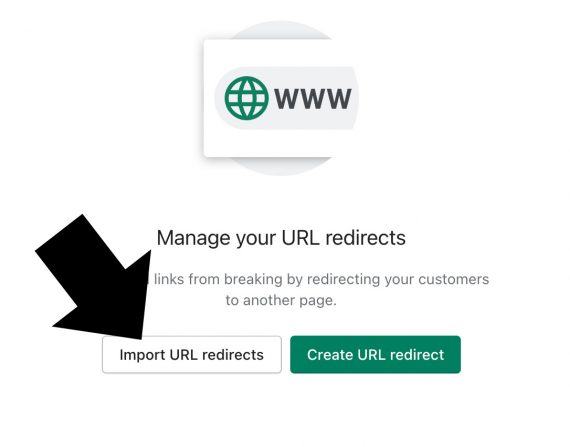





The import link is initially on the same screen as the green create URL redirect button.
After creating a single 301 URL redirect, the page format changes, and the “Import” link appears on the upper right side of the page, which displays a table of all redirects.






After creating a URL redirect, the import link is shown in the upper right of the page, which shows a table of all of the store’s redirects.
Shopify displays a simple tool in a modal to upload the CSV file, and just like that, a business can upload hundreds of redirects at once.






This modal is how a store administrator can upload a properly formatted CSV file of 301 redirects.
Having set up 301 redirects for a Shopify store, a store administrator will occasionally need to manage them, such as:
To find a specific redirect, search for it on the URL redirect page. Search results are filterable by the creation date — handy for finding old redirects— and can be saved.






Shopify permits the searching and filtering of URL redirects.
To edit a specific 301 redirect, click the URL from the table on the main URL redirect page — this is the individual redirect page described above. Shopify will then open the original redirect form. Make the change and save.
From the same individual redirect page, a simple click will delete the URL redirect. (Shopify helpfully asks for confirmation before it deletes.)






The red-outlined “Delete redirect” button is at the bottom of each individual URL redirect page.
Finally, exporting a list of URL redirects from Shopify is sometimes necessary. The export link is on the main URL redirect page next to the “Import” link described above.
301 redirects are an important part of managing any website. Shopify makes setting up redirects easy, and the platform’s bulk upload feature is a lifesaver when it comes to larger projects.
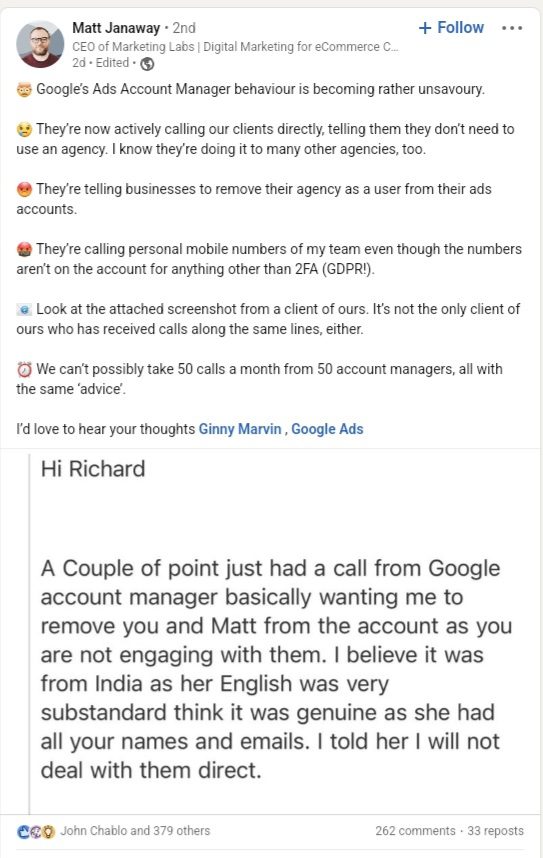
There are a growing number of reports across the web of Google Ads accounts managers threatening to contact clients directly, despite not being allowed to.
According to the reports, agencies who don’t respond to emails from Google Ads account managers are being met with threats from Google reps to contact clients directly.
In some cases, the Google Ads account managers call clients and tell them to drop their agencies.
There are two things to make clear here:
A Google Ads rep telling clients to fire their agency crosses the line.
However, these reports are becoming more frequent.
Matt Janaway, CEO of Marketing Labs, shared his experience on LinkedIn this week:






Janaway’s post caught the attention of Google Ads Liaison Ginny Marvin, who says the issue will be addressed “immediately.”
Marvin adds, “This is not in line with how we expect our team to support our advertisers and agency partners.”






Janaway isn’t alone in his experience.
Throughout October, reports circulated on Reddit of Google reps engaging in similar practices.
One Reddit user posted a screenshot of an email received by a Google Ads Account Strategist, which reads:
“I am writing to you one last time as a courtesy, because my honest goal is to provide you value and advanced strategies with google ads and work with you closely, to help you save time and make your clients more successful with google ads , thus I am contacting you for the last time to inform you that if I do not reach you, I will assume that you are not getting my emails and will contact the clients that I have been assigned directly.”
Another Reddit user has nearly the same story, saying they’ve been “harassed” with daily emails from a Google Ads rep to get on a call and implement campaign changes.
Again, agencies aren’t obligated to speak with Google reps or implement changes clients aren’t asking for.
Should you receive an email like the one above, the best thing to do is submit a complaint via Google’s official form.
Beware of these aggressive sales tactics. As long as you’re not breaking any policies, Google has no say over how you run your clients’ campaigns.
Featured Image: FGC/Shutterstock